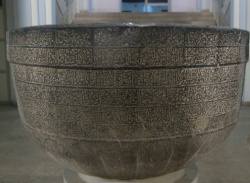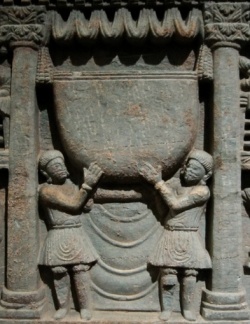The Buddha's Begging Bowl
One of the most revered relics in the ancient Buddhist world was the Buddha’s begging bowl. A rough outline of its long convoluted history is this – it was supposedly given to the people of Vesali when the Buddha passed through the city on his way to Kusinara.In the 1st/2n century King Kanishka took it to Pushapura, now Peshawar, where a string of Chinese pilgrims reported seeing it between the 3rd and the 9th centuries. The importance of the bowl is attested by numerous depictions of it in Ghandara art, usually shown on the pedestal of Buddha statues. During the Islamic period it was taken from one palace or mosque to another until at a date unknown it ended up in Sultan Ways Bābā’s shrine on the outskirts of Kandahar. Several British officers report seeing in there in the 19th century, one attempting to translate the inscription on it, and another, Alexander Cunningham, trying to trace its history, a fact I mention in my Middle Land Middle Way (1992, p.136). In the late 1980s during Afghanistan’s civil war President Najibullah had the bowl taken to Kabul’s National Museum. When the Taliban came to power their Minister of Culture ordered all Buddhist artifacts in the museum smashed although the bowl remained undamaged, no doubt because of the Quranic verses inscribed on its outer surface. Today the bowl is displayed at the entrance of the Museum.
The bowl is not small. It is a stone hemispherical vessel of greenish-grey granite with a diameter of about 1.75 meters, a height of about three ¾ of a meter, and a thickness of about 18 cm at its rim, rather thicker elsewhere particularly at its middle and the base. It has no cracks or abrasions, except for a portion about the size of the palm of one’s hand that has flaked away from near the rim. There is a delicate lotus petal design chiseled around its base, attesting to its Buddhist past, and, inscribed in beautiful large calligraphic script horizontally along the rim of the bowl, are six rows of verses from the Quran, reflecting its Islamic continuum and its status through the ages as an object of special religious interest. Traces of similar calligraphic script are visible on the surface on the inner side of the bowl. The bowl is about 350 to 400 kg in weigh, far too heavy to lift.
The bowl was probably an early larger copy of the Buddha’s actual bowl placed in a monastery in Vesali for people to offer their first fruits in, a custom common in ancient India and which survived even in Sri Lanka and elsewhere up to the 19th century. The bowl’s great size may well have encouraged the acceptance of the widespread belief amongst ancient Buddhists that the Buddha was 18 feet tall. Only someone that big could have used or even lifted a bowl this size.
I am writing about the Buddha’s begging bowl because after being in obscurity for so long it recently hit the headlines in India when it was mentioned in the Lok Sabha, India’s parliament. I reproduce the below from the Ministry of External Affairs website.
MP Dr. Raghuvansh Prasad Singh asked; “Will the Minister of External Affairs be pleased to state: (a) whether the Government has recently got the information that the begging bowl of Buddha, given to the people of Vaishali by him, has been found in the Kabul museum; (b) if so, the details thereof; (c) whether the Indian Embassy in Afghanistan has sent a photo of the said bowl to the Government; (d) if so, the details thereof; (e) whether the Government has initiated the process to recover the said bowl; (f) if so, the details thereof; (g) whether the travelogues of the Chinese pilgrim Fa-hein and the writings of Dr. Cunningham and Shri S.V. Sahni mention the said bowl; and (h) if so, the details thereof?”
The Minister Prenteet Kaur in reply answered; “The Embassy of India, Kabul has made enquiries in the matter. It is learnt that the item purported to be Lord Buddha’s begging bowl was apparently in Kandahar until the regime of former President Najibullah. It was later brought to Kabul and is currently in the Kabul Museum. It has been pointed out that the begging bowl, a photo of which our Embassy has obtained, is rather large, besides having inscription in Arabic and Persian, thus calling into question its provenance. The Archaeological Survey of India has been requested to convey any information or advice it may have regarding the provenance of the bowl currently in Kabul Museum”.

